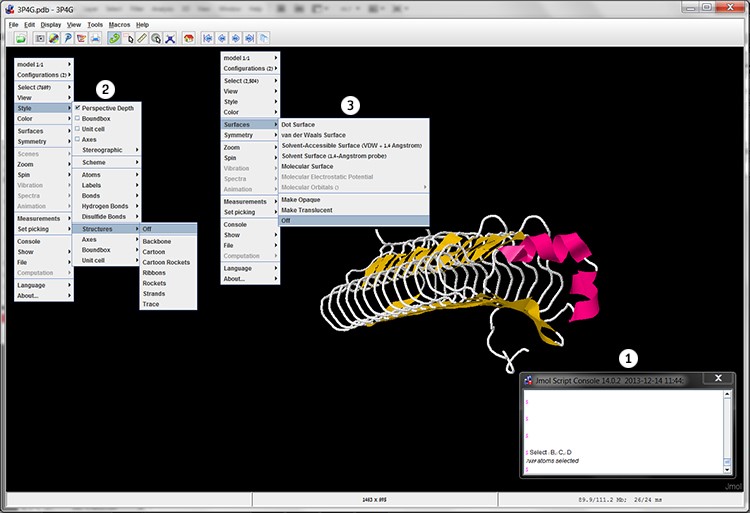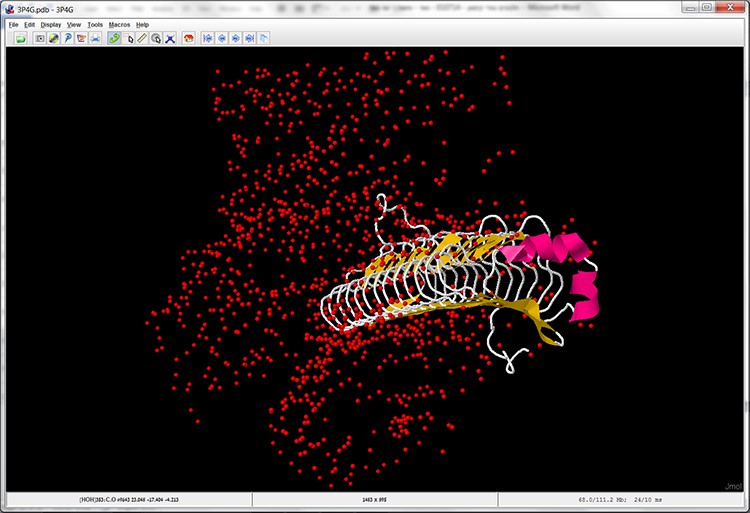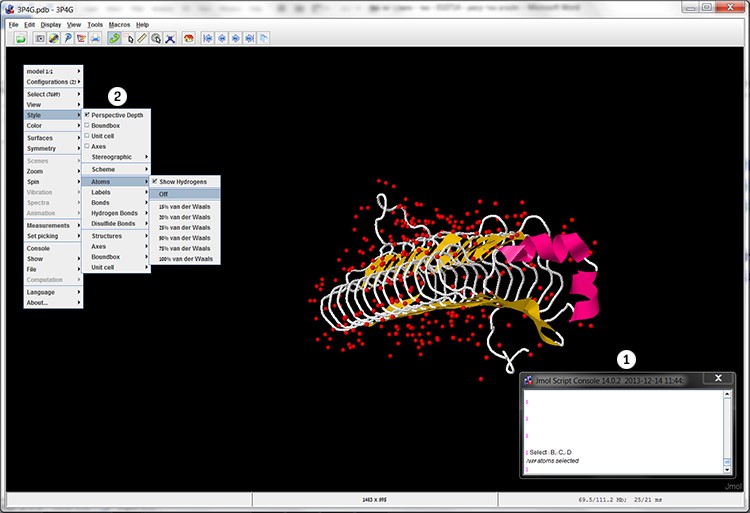Focusing on and studying the structure of one subunit in the MpAFP protein
The scientists discovered that the protein is composed of 4 subunits, with each subunit having a pipe like spatial structure, made of beta sheets connected with loops.
In order to study the structure of the area functioning as antifreeze, we will focus on subunit A.
In order to display only subunit A, we must remove the rest of the subunits. Therefore we will perform the following:
- Right click the mouse in the workspace, and in the additional options menu pick Console.
- In the console, right after the $ sign, type Select :B,:C,:D: and press Enter.
- The tool is showing us the number of atoms in the selected component, in this case 7689 atoms.
- Right click the mouse in the workspace and pick Style ➔ Structure ➔ Off
(picking Off “switches off” and hides the selected component). - The three selected subunits are not displayed; only subunit A and the surface area of subunit C are displayed.
8. How do you think we can remove the surface area of subunit C from the display?
Choose one answer:
- First we select subunit C using the Select: C command in the console window, then in the additional options menu we pick Surfaces ➔ van der Waals Surface.
- In the additional options menu we pick Surfaces ➔ van der Waals Surface, and then perform the command on subunit C using the command Select: C in the console window.
- Hide all of the surface area with Surfaces ➔ Off.
- We select subunit C using the command Select: C in the console window, then in the additional options menu we hide the atoms of this subunit using the command Atoms ➔ Off.
The correct answer is: C. There is no need to select a specific subunit, but only to hide the surface area of all the subunits in the structure (screen 9).

Screen 9: Cartoon display only of subunit A of the MpAFP protein, after selecting the other 3 subunits (1), after hiding their structure (2), and after hiding the surface area display (3).
The subunits of the MpAFP protein are supposed to be in contact with water molecules, and prevent them from forming into ice particles.
9. Are the water molecules displayed in this form of display (Cartoon, secondary structure)?
- Yes
- No
The correct answer is: b. No. The water molecules marked as red circles in the Balls and Sticks display are not part of the Cartoon display and therefore are not displayed.
In order for water molecules to appear in the displayed model, right click the mouse, and in the additional options menu pick:
To select all of the water molecules Select ➔ Hetero➔ All water
To determine the volume of the water molecules, so that they are prominently displayed Style ➔ Atoms ➔ 25% van der Waals
To change the color of the water molecules to red Color ➔ Atoms ➔ Red
Now the water molecules are displayed in red, while subunit A is displayed in the secondary structure display (screen 10).

Screen 10: Cartoon display of subunit A of the protein MpAFP with all of the water molecules in the structure (the oxygen atom in each water molecule is presented as a red sphere).
10. It is likely that the water molecules in this display are connected to the protein with hydrogen bonds. How can we explain the presence of water molecules that are far from the displayed subunit A?
In the first command all of the water molecules in the structure were selected: those connected to subunit A and located near it, and those connected to the other subunits (C, B and D) and located far from subunit A. In order to display only subunit A and the water molecules connected to it, we must erase the other subunits again, and then the water molecules connected to them will also be erased.
11. What command order will display only subunit A and the water molecules connected to it?
Choose one answer:
- In the console type Select: B:C:D and then in the additional options menu pick Style ➔ Atoms ➔ Off.
- In the console type Select: A and then in the additional options menu pick Style ➔ Atoms ➔ Off.
- Right click the mouse and in the additional options menu pick Select ➔ Hetero ➔ All water and then pick Style ➔ Atoms ➔ Off.
- In the console type Select: B,:C,:D and then in the additional options menu pick Style ➔ Atoms ➔ Off.
The correct answer is: D. selecting subunits C, B and D and the water molecules connected to them is performed with the command Select: B,:C,:D in the console window. The command Style ➔ Atoms ➔ Off erases the selected atoms from the model (screen 11).

Screen 11: Cartoon display of subunit A in the protein MpAFP with the water molecules connected to this subunit only, after selecting the other subunits (1) and hiding the atoms of these subunits (2).
12. Perform the correct command order as written in the answer to the previous question, and answer the following question:
Where are the water molecules located, relatively to subunit A of the MpAFP protein?
Choose one answer:
- Only on the external surface area of subunit A.
- In the external surface area of subunit A and also in the core of the subunit.
- Mainly in the core of subunit A, but also on the external surface area of the subunit.
- In the core of subunit A.
The correct answer is: A. On the external surface area of subunit A.
After we managed to display only subunit A and the water molecules connected to it, we can investigate in depth which components in the subunit bind the water molecules and other molecules as well, and how these bonds contribute to the stability of the spatial structure and the function of the protein as antifreeze.